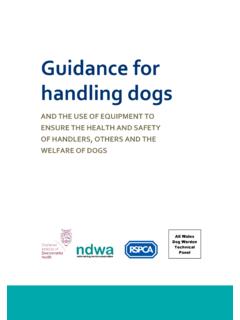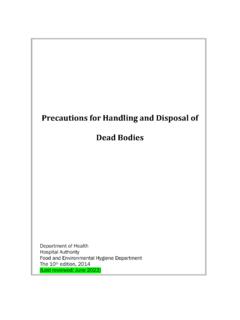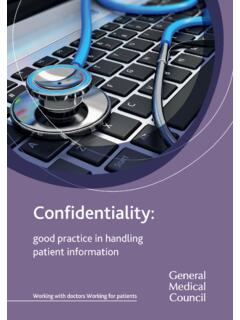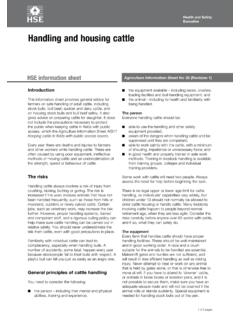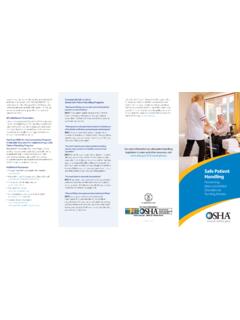Transcription of Manual handling assessment charts (the MAC tool)
1 Health and Safety ExecutivePage 1 of 15 Introduction Work-related musculoskeletal disorders (MSDs), including Manual handling injuries, are the most common type of occupational ill health in the UK. It is important to remember that: there is a lot you can do to prevent them; preventative measures are often simple and cost-effective; you cannot prevent all MSDs, but where they occur, early reporting of symptoms, proper treatment and suitable rehabilitation are Manual handling assessment charts (MAC) is a tool aimed at employers, health and safety managers and safety representatives and is used by health and safety inspectors. The tool will help individuals to assess the most common risk factors in lifting (and lowering), carrying and team handling operations and was developed to identify high-risk Manual does the law say?
2 The Manual handling Operations Regulations 1992 set out a clear hierarchy of measures for dealing with risk likely to cause harm from Manual handling . These are: avoid hazardous Manual handling operations so far as reasonably practicable; assess any Manual handling operations that cannot be avoided; reduce the risk of injury to as low as reasonably practicable. Structure of the MAC There are three types of assessment that can be carried out with the MAC: lifting operations (pages 3 6); carrying operations (pages 7 10); team handling operations (pages 11 13). For each type of assessment there is an assessment guide and a flow chart . There is a score sheet (the MAC: Score sheet ) to complete on page handling assessment charts (the MAC tool) This is a web-friendly version of leaflet INDG383(rev2), published 06/14 Note The MAC is not appropriate for some Manual handling operations, for example those that involve pushing and pulling.
3 Its use does not comprise a full risk assessment (see Manual handling in Further reading ). Always consider individual and psychosocial issues when completing the MAC: Score sheet . Also, the MAC is not designed to assess risks associated with workplace upper limb disorders (see Upper limb disorders in the workplace and assessment of Repetitive Tasks of the upper limbs (the ART tool) in Further reading ).Health and Safety ExecutiveManual handling assessment charts (the MAC tool) Page 2 of 15 How to complete a MAC assessmentG = GREEN - Low level of risk Although the risk is low, consider the exposure levels for vulnerable groups such as pregnant women or young workers, where = AMBER - Medium level of risk Examine tasks = RED - High level of risk Prompt action needed. This may expose a significant proportion of the working population to risk of = PURPLE - Very high level of riskSuch operations may represent a serious risk of injury and should come under close scrutiny, particularly when the entire weight of the load is supported by one person.
4 Spend some time observing the task (videoing may help) to ensure that what you are seeing is representative of normal working procedures. You should involve your employees and safety representatives during the assessment process. Where several people do the same task, make sure you have some insight into the demands of the job from all employees perspective. Select the appropriate type of assessment (ie lifting, carrying or team handling ). If a task involves lifting and carrying, consider both. Follow the appropriate assessment guide and flow chart to determine the level of risk for each risk factor. Information on risk reduction can be found on the HSE website at and in the HSE publication Manual handling at work (see Further reading ). Enter the colour band and corresponding numerical score on the MAC: Score sheet.
5 The colour bands help determine which elements of the task require attention. Enter the remaining task information and use the scores to help identify which risk factors need to be examined and the total level of exposure to risk. If the individual does a number of tasks, assess each one separately and prioritise action to address the highest scoring task. Further guidance on using the MAC tool can be accessed online at The purpose of the assessment is to identify and then reduce the overall level of risk of the and Safety ExecutiveManual handling assessment charts (the MAC tool) Page 3 of 15 assessment guide for lifting operations A Load weight/frequency Note the weight of the load and the repetition rate of the lifting operation. Take note of the risk banding from the graph below and enter the colour band and numerical score onto the MAC: Score sheet.
6 If the colour band is purple, the task should be examined very closely, as such operations may represent a serious risk of injury and should come under close scrutiny, particularly when the entire weight of the load is supported by one person. Note: High frequency handling operations of light weights will fall within the green zone, but may be associated with upper limb problems. Please refer to Upper limb disorders in the workplace and assessment of Repetitive Tasks of the upper limbs (the ART tool) (see Further reading ) for advice on further assessment . R=6A=4G=0P=100 One lift perday30 minutes(2)5 minutes(12)2 minutes(30)1 minute(60)14 seconds(250)9 seconds(400)5 seconds(720)102030405001020304050 Weight of load (kg)One lift every(lifts per hour)Load weight/frequency graph for lifting operationsHealth and Safety ExecutiveManual handling assessment charts (the MAC tool) Page 4 of 15 Floor levelor belowAt head height or aboveB Hand distance from the lower back Observe the task and examine the horizontal distance between the operative s hands and their lower back.
7 Always assess the worst case scenario . Use the following to guide your assessment : C Vertical lift region Observe the position of the operative s hands at the start of the lift and as the lift progresses. Always assess the worst case scenario . Use the following illustrations as a guide: D Torso twisting and sideways bending Observe the operative s torso as the load is lifted. If the torso twists in relation to the hips and thighs or the operative leans to one side as the load is lifted, the colour band is amber and the numerical score is 1. If the torso both twists and bends to the side as the load is lifted the colour band is red and the numerical score is 2. Close: Upper arms aligned vertically and upright torsoG/0 Moderate: Upper arms angled away from bodyA/3 Moderate: Torso bent forwardA/3 Far.
8 Upper arms angled away from body and torso bent forwardR/6 Above knee and/or below elbow heightG/0 Below knee and/or above elbow heightA/1R/3 Little or no torso twisting or sideways bendingG/0 Torso twisting or sideways bendingA/1 Torso twisting and sideways bendingR/2 Health and Safety ExecutiveManual handling assessment charts (the MAC tool) Page 5 of 15 Dry and clean floor in good conditionG/0 Dry floor but in poor condition, worn orunevenA/1 Contaminated/wet or steep sloping floor or unstable surface or unsuitable footwearR/2E Postural constraints If the movements of the operative are unhindered, the colour band is green and the numerical score is 0. If the operative adopts restricted postures during the lift because of the space available (eg a narrow gap between pallet load and hopper) or the workstation design (eg an excessively high monorail conveyor), the colour band is amber and the numerical score is 1.
9 If the posture is severely restricted, the colour band is red and the numerical score is 3 (eg work in confined areas such as baggage holds). F Grip on the loadG Floor surface H Other environmental factors Observe the work environment and score if the lifting operation takes place: in extremes of temperature; with strong air movements; or in extreme lighting conditions (too dark or bright). If one of the risk factors is present score 1, if two or more of the risk factors are present score 2. No postural constraintsG/0 Restricted postureA/1 Severely restricted postureR/3 Loose parts enabling comfortable gripFingers to be clamped at 90 degrees under the containerNon-rigid sacks or unpredictable loadsGood gripG/0 Reasonable gripA/1 Poor gripR/2 Containers with well- designed handles or handholds, fit for purposeContainers with poor handles or handholdsContainers of poor design.
10 Loose parts, irregular objects, bulky or difficult to handleNo factors presentG/0 One factor presentA/1 Two or more factors presentR/2 Health and Safety ExecutiveManual handling assessment charts (the MAC tool) Page 6 of 15 Torso twisting andsideways bending2 RTorso twisting orsideways bending1 ALittle or no torsotwisting or sideways bending0 GTorso twistingand sideways bendingDSeverelyrestricted3 RRestricted1 ANone0 GPosturalconstraintsEFloor level or belowand/or abovehead height3 RBelow knee and/or above elbow height1 AAbove knee and/or below elbowheight0 GVertical liftregionCPoor2 RReasonable1 AGood0 GGrip on the loadFFar: upper armsangled and torsobent forward6 RModerate: upperarms angled ortorso bent forward3 AClose: upper arms vertical/torsoupright0 GHand distancefrom lowerbackBContaminated,wet, sloping orunstable2 RDry but in poorcondition oruneven1 ADry and in goodcondition0 GFloorsurfaceGTwo or morefactors present2 ROne factorpresent1 ANo factorspresent0 GOtherenvironmentalfactorsHNOTE THE COLOUR AND NUMERICAL SCORE AND INSERT ON SCORE SHEETSee graph on p30 GSee graph on p34 ASee graph on p36R50 kg or more10 PLoad weight/frequency (seegraph on p3)ALiftingoperationPlease insert the colour andnumerical scores on the MAC: Score sheet Health and Safety ExecutiveManual handling assessment charts (the MAC tool) Page 7 of 15 assessment guide for carrying operationsA Load weight/frequency Note the weight of the load and the frequency of the carrying operation.











